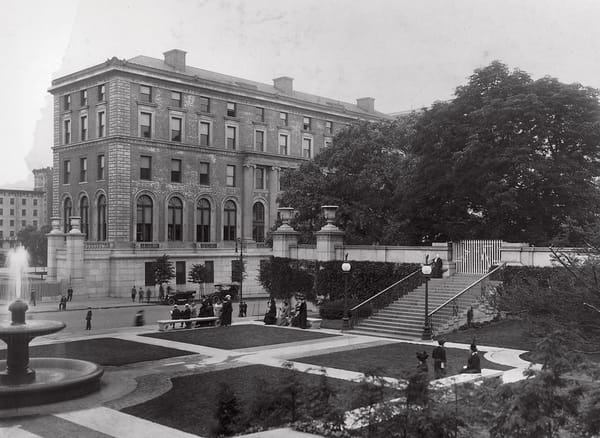Radically Considering Spatial Justice: Public Space, Inclusivity, and Ethical Social Architecture
The concept of spatial justice emerges as a central component of justice as a contemporary topic; in this way, the very bedrock of justice itself becomes more dynamic and flexible to the changing conditions of our social world.

It is the end of the furthest run I have ever tried in DC and just as I get ready to complete the final mile, I stop on the corner of Columbia Road and 18th Street to stare at the monstrosity looking back at me. For the first time, the terraces and cobbled pavement of Adams Morgan Plaza are obscured from view, hidden behind barbed wire fences and a sign reading “no trespassing.” Adams Morgan Plaza is just one example of the many reasons why public space is incredibly essential but uniquely fragile within the context of urban living, prone to spontaneous closures and government interference that jeopardize it. According to Setha Low—Distinguished Professor of Environmental Psychology, Geography, Anthropology, and Women’s Studies at the Graduate Center of the City University of New York—, “public space contributes to the flourishing of individuals, communities, cities, and societies” (Low 2023, 9). At the same time, it “goes beyond the usual standards of what urban planners and designers mean by well-designed space, considering what it is to be human and an agent in one’s own life” (Low 2023, 9). Thus, while the nature of public space invites societies to consider how humans engage with one another within the built environment, it also inspires careful contemplation of how the fundamental principles of justice appear in relation to public space. Exploring the nature of spatial justice therefore becomes an essential element in our deliberations about what justice means as a holistic and interdisciplinary idea. By examining prevalent philosophies and critical literature about the social and political aspects of space writ large, the concept of spatial justice emerges as a central component of justice as a contemporary topic; in this way, the very bedrock of justice itself becomes more dynamic and flexible to the changing conditions of our social world.
By considering the philosophical difference between space and place, spatial justice surfaces as a vibrant and pervasive concept that can mediate the way social collectives engage with the many facets of space structured around equity. To begin this conversation about the philosophical components of spatial justice, it is important to distinguish the two notions of space and place. While this distinction has come up frequently in class, reiterating its importance allows for a more fundamental understanding of spatial justice as a philosophy. Space can largely refer to a number of different things, for instance, the vast expanse of our universe beyond earth. However, in the broadest sense of the word, space philosophically designates any area or region that is of interest to anything or anyone. The notion of social space is more acutely relevant to the urban areas that concern this paper; broadly, social space balances both a critical perspective on urban and everyday life (Middleton 2013, 28). These two experiences, linked together, occupy a categorical social space that is created through the interaction of these two elements—the urban and cotidian—of life itself (Middleton 2013, 28). On the other hand, a place is rooted in even more than just the social sphere, occupying a significant position in the histories, experiences, and memories of a society. Where space collides with life, place is created by life and the routine, tradition, and almost ritualistic practices of a variety of different people from all parts of the social environment anywhere. The notion of place is therefore grounded more in the consciousness of the individual and embedded within patterns of ongoing human behaviors that have enfolded the external into the internal dynamics of private life. Based on these distinctions, spatial justice becomes necessary to ground the nebulous nature of space and “social space” in the priorities that concern not just the individual or habituated experiences of one collective, but a mosaic of people. Place is perpetually defined and redetermined through direct use and engagement by the microscopic human units of a city or region; space must grapple with a plurality of different conceptions of what a “place” should look like, mediating the desires of singular people with a broad, “general will” (Rousseau, Cress, and Wootton 2011). This very idea of a “general will” further distinguishes place from space, where space must perpetually wrestle with individual intentions to settle on an all-encompassing aim for the benefit of all (Rousseau, Cress, and Wootton 2011). Spatial justice reconciles this general will with the fundamental principles of justice itself by acknowledging both the importance and fragility of space as a philosophical concept. As space seeks to be inclusive, public, goal-oriented, and political, spatial justice must mediate the ways communities show up in both the metaphorical and physicalized architecture of space itself.
Expanding on these philosophical conceptions, public space demands consideration as an ideal form of just space, providing the necessary foundation for spatial justice to equalize access, ownership, purpose, and thus the politics of space. The first central philosophical principle of spatial justice must be access; without determining exactly what this means, societies have no way of determining how to qualify our engagement with spaces of any kind. By nature, exclusionary spaces work against the fundamental principle of representational justice; preventing certain groups from accessing space exacerbates the stratification of social identities. To strive towards space that is just, access to spaces must be aimed to a public that strives to privilege anyone who may seek to use open space. Limiting access to open space works against this fundamental aspect of spatial justice and presents a serious affront to the moral values of institutions that enforce restrictions on open space (Barrett 2023a). Subsequently, ownership of space must grapple with this idea of access arbitrated by both private and public institutions. When access to space is designed for the public, public intuitions—like the government—establish a sense of public ownership of space. Though the space might be monitored by a small portion of people, its public nature establishes a sense of communal ownership and care. Contrastingly, private ownership of space restricts the public; justice is achieved by representing a public interest in the private sphere. Space is also defined by specific purposes; ensuring that these meet a rigorous ethical standard that is also public facing classifies space as just. Beyond designing open space for a public purpose, private space must aim towards an ethical purpose that prioritizes social good (Barrett 2023b). When these spaces are made marginal, institutions—both public and private—risk establishing space that prioritizes the few over the many or even the right over the good. Synthesizing these many elements of spatial justice, the overarching politics of space exists as the gateway to establishing equity. Protest, resistance, and the redefinition of space provide the political mechanisms to renew the access, ownership, and purpose of spaces. As a result, spatial justice is reliant on spatial politics as a systematic framework to engage in the betterment of spaces for the better, resisting harmful and selective restrictions. Low’s Why Public Space Matters articulates the importance of politics to achieve spatial justice, providing an angle to critique and empower existing spaces for the better.
Beyond exploring the importance of open urban areas, Why Public Space Matters illustrates the centrality of spatial justice as a principle to characterize the evolution of space and its role in society over time. In her chapter about social justice, public space, and Jones Beach, Low mentions that “scholars argue that a ‘just city’ should be the criterion for allocating urban space” (Low 2023, 58). These thinkers “propose a planning theory based on distributive justice to produce a better city for all” (Low 2023, 58). This focus on “distributive justice” deals directly with the fairness of outcomes that space should actively seek for members of urban communities across all backgrounds. Thus, a central principle of spatial justice must deal with both the distribution of spaces as well as an equal allocation of its benefits. Doing so allows a combination of scholars and urban designers to strive to create a “just city” that acknowledges difference while uplifting social participation in public spaces. Similarly, Low highlights that “‘spatial justice’ in a city has an even broader meaning that includes freedom, liberty, equality, democracy, and civil rights” (Low 2023, 58). These subsequent components task spatial justice with the essential responsibility to ensure that these values—and most essentially “civil rights”—are integrated in spaces throughout society. In this instance, Low’s use of listing emboldens once again the vital and multifaceted purpose of spatial justice “in a city” specifically. This literary method grounds the abstract nature of spatial justice in concretized, explicitly stated purposes that heighten its relevance to tangible spaces. Consequently, spaces—public and private—are mobilized to uplift a dualistic focus that centers both individual and collective lived experiences within a real-world context. In addition to these values, Low argues that there are more forms of justice and morality that must factor into the social experience of space writ large: representational justice and an ethic of care are important as well (Low 2023, 59). Incorporating these ideas into “a unified framework offers a normative stance on what constitutes a ‘good’ public space” (Low 2023, 59). Quotation marks placed on the term “good” emphasizes the subjectivity of the term; while others might consider a space to be “good,” others may argue otherwise based on a personal dissonance between internal identity and the ostensible purpose of public space. Therefore, paying attention to the ways people see themselves reflected in the histories, activities, and goals of space enhances individual agency of people to access these areas through representational justice. Simultaneously, this prioritization of access promotes an ethic of care based around a community that sees its diversity reflected in the fundamental aspects of spaces. Concluding her chapter, Low suggests that all public spaces can “contribute to social justice and a sense of belonging” but are inhibited when “designed or governed solely for a limited and exclusive public” (Low 2023, 62). Repetition of the words “solely,” “limited,” and “exclusive” emphasize Low’s critical attitude towards spaces restricted to portions of the public. To truly cultivate a sense of social justice and belonging, spaces must resist the narrative of this language, actualizing spatial justice through radical inclusivity.
In summary, spatial justice is not only philosophically connected to the fundamental notion of justice itself but remains tied to the notion of social justice through Low’s writings on public space. But beyond these methods of analysis, why is spatial justice so imperative? Why must it pertain directly to the bedrock principles of justice explored in this course? Urban, rural, and social space deals directly with the way humans live their lives every single day. From sidewalks and roads to parks and playgrounds, spatial justice governs how individuals move through their environment every moment. To mediate this socio-spatial culture complexified by urban life, spatial justice provides an avenue for us to evaluate the way we include social groups in our conception of what space—and therefore society itself—must strive to uplift and prioritize. We cannot consider modern ways of living without simultaneously paying attention to the new ways societies engage with built and naturalistic spaces. Only by bringing spatial justice into a public consciousness can we amend and avoid the reenactment of the historical exclusion of marginalized groups from physical, metaphorical, political, and public spaces. If nothing else, spatial justice grapples with the necessity of inclusivity in all areas of the social experience. Thus, for other areas of justice, spatial justice provides a new way of conceptualizing inclusivity that can radically enhance the dynamism of justice as a living, breathing thing.
References
Barrett, Ishaan. 2023a. “Hostile Architecture and the Fourth Purpose: How Columbia’s Gate Closures Work against the University and Public Good.” Columbia Daily Spectator, November 1, 2023, sec. Opinion. https://www.columbiaspectator.com/opinion/2023/11/01/hostile-architecture-and-the-fourth-purpose-how-columbias-gate-closures-work-against-the-university-and-public-good/.
———. 2023b. “Manhattanville and Columbia’s New Renovations Leave Little Breathing Room for the Arts and Humanities.” Columbia Daily Spectator. November 29, 2023. https://www.columbiaspectator.com/opinion/2023/11/29/manhattanville-and-columbias-new-renovations-leave-little-breathing-room-for-the-arts-and-humanities/.
Low, Setha M. 2023. Why Public Space Matters. Oxford University Press.
Middleton, Sue. 2013. “Production of Space.” In Henri Lefebvre and Education: Space, History, and Theory, 28–57. Taylor and Francis.
Rousseau, Jean-Jacques, Donald A Cress, and David Wootton. 2011. Basic Political Writings. Hackett Publishing Company.





